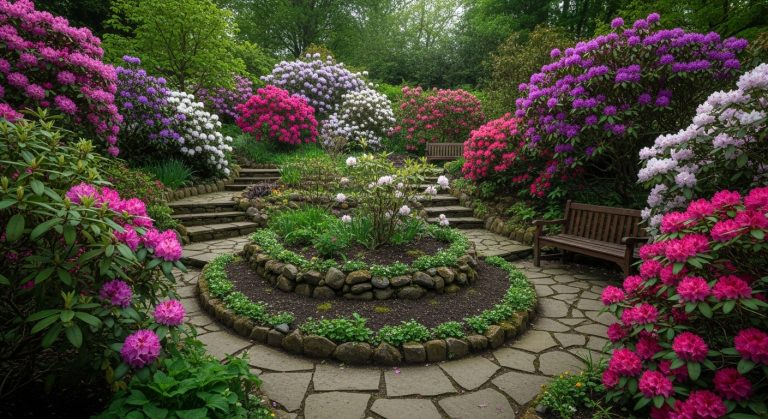15 Villa Garden Design Ideas That Elevate Outdoor Living
Ever walked past a villa and felt instantly drawn in by the lush garden surrounding it? That feeling of elegance, calm, and a touch of luxury is what makes villa gardens so special. I remember visiting a friend’s villa last summer, and the moment I stepped into the backyard, I felt like I’d entered a living artwork — structured greenery, pops of color, and perfectly placed seating made it impossible not to pause and take it all in.
Villa gardens aren’t just about looks; they’re about creating spaces where you can relax, entertain, or simply admire nature. The best part is, designing one doesn’t always mean splurging on grand fountains or exotic plants. Small details, thoughtful layouts, and a mix of textures can transform even a modest villa backyard into a serene retreat. Over the years, I’ve experimented with terraces, floral borders, water features, and cozy nooks, and I’ve seen firsthand how the right garden design can elevate the entire property.
Below, I’ve gathered 15 practical, visually stunning villa garden design ideas. Each one comes with real-life pros, realistic cons, and actionable takeaways to help you create a villa garden that’s both elegant and achievable.
1. Symmetrical Formal Garden
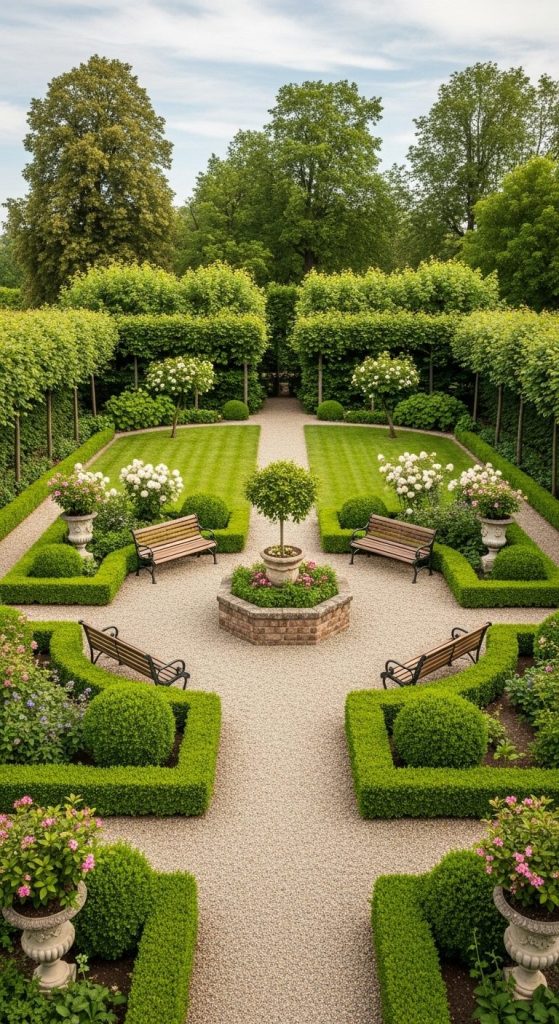
A symmetrical layout immediately conveys elegance and balance, perfect for front yards or central villa courtyards. Think neatly trimmed hedges, central pathways, and matched planters.
Pros
- Creates a timeless, luxurious feel.
- Easy to maintain once hedges and beds are established.
- Enhances villa architecture and entrance appeal.
Cons
- Requires precise planting and occasional trimming.
- Less forgiving if plants grow unevenly.
Takeaway: A formal garden makes your villa look refined and organized, setting a classy tone from the start.
2. Terrace Garden with Potted Layers
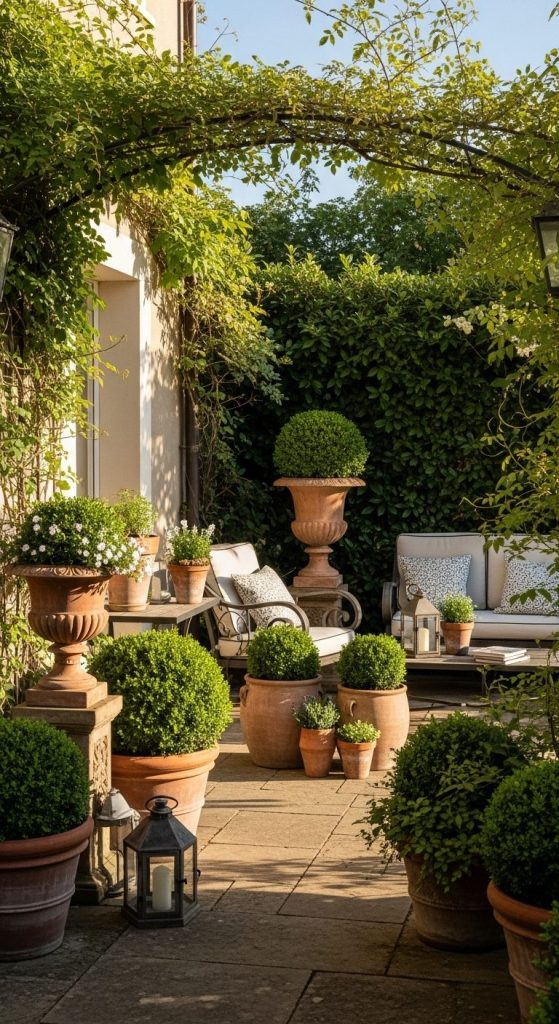
Terrace gardens maximize outdoor space, especially for villas with balconies or multiple levels. A mix of potted plants, small shrubs, and decorative urns adds depth and color.
Pros
- Flexible layout; plants can be moved seasonally.
- Adds greenery without needing extra soil beds.
- Creates cozy nooks for coffee or reading.
Cons
- Pots need regular watering and maintenance.
- Weight considerations on upper terraces.
Takeaway: Even small terraces can feel lush and inviting with layered potted arrangements.
3. Stone Pathway with Green Borders
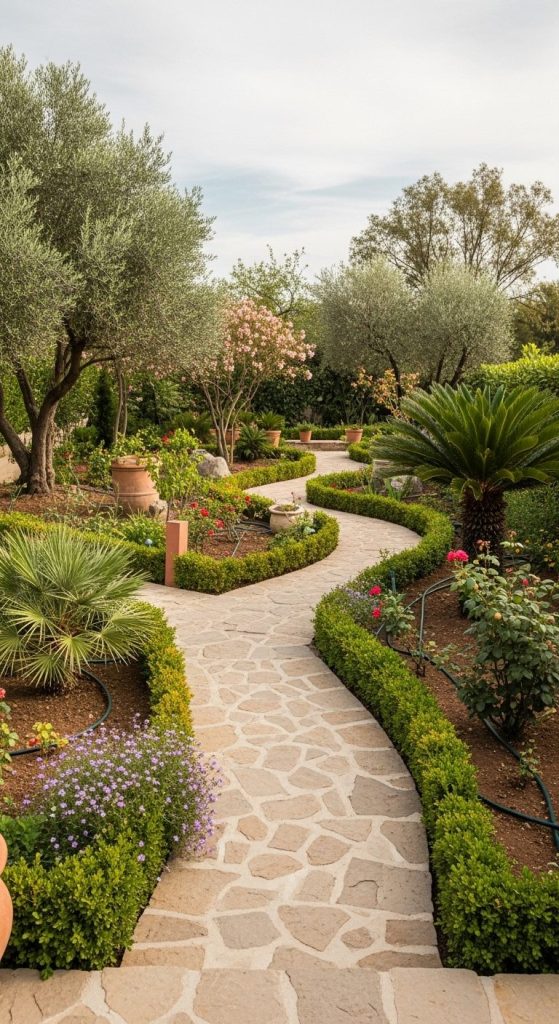
A winding stone path through a villa garden adds movement and charm. Pair with low hedges, flowering shrubs, or small palms for a classic villa aesthetic.
Pros
- Connects different garden zones logically.
- Adds texture and visual interest.
- Low-maintenance once stones are set.
Cons
- Stone installation requires upfront work.
- Path edges may need trimming to prevent overgrowth.
Takeaway: A well-planned stone path makes your garden feel like a serene journey rather than just a static space.
4. Water Fountain Centerpiece
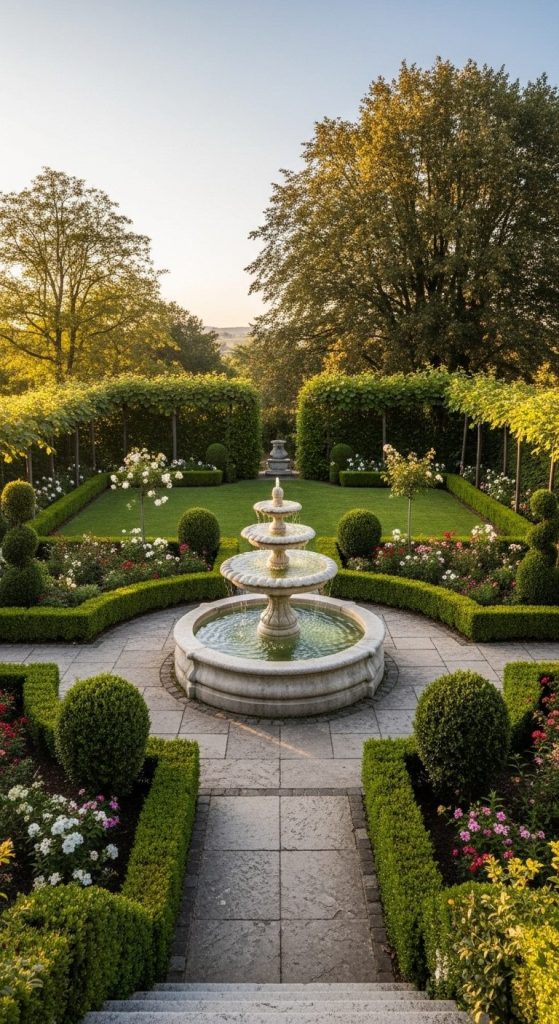
Nothing elevates a villa garden like a central fountain. It can be modern, tiered, or classic marble — a focal point that sets the mood.
Pros
- Creates a calming ambiance with natural sound.
- Serves as a visual anchor for symmetry.
- Attracts birds and small wildlife.
Cons
- Requires plumbing and maintenance.
- Initial installation can be costly.
Takeaway: A fountain instantly signals luxury and serenity, becoming the heart of your garden.
5. Flower Borders with Seasonal Rotation

Planting a mix of perennials and seasonal flowers along edges adds color throughout the year. I’ve tried alternating roses, marigolds, and salvias for continuous blooms.
Pros
- Keeps the garden lively across seasons.
- Can highlight pathways and patios.
- Flexible combinations allow creative expression.
Cons
- Seasonal planting requires planning.
- Different flowers may have varying water needs.
Takeaway: Thoughtful flower borders keep the villa garden vibrant and ever-changing.
6. Shaded Lounge Areas
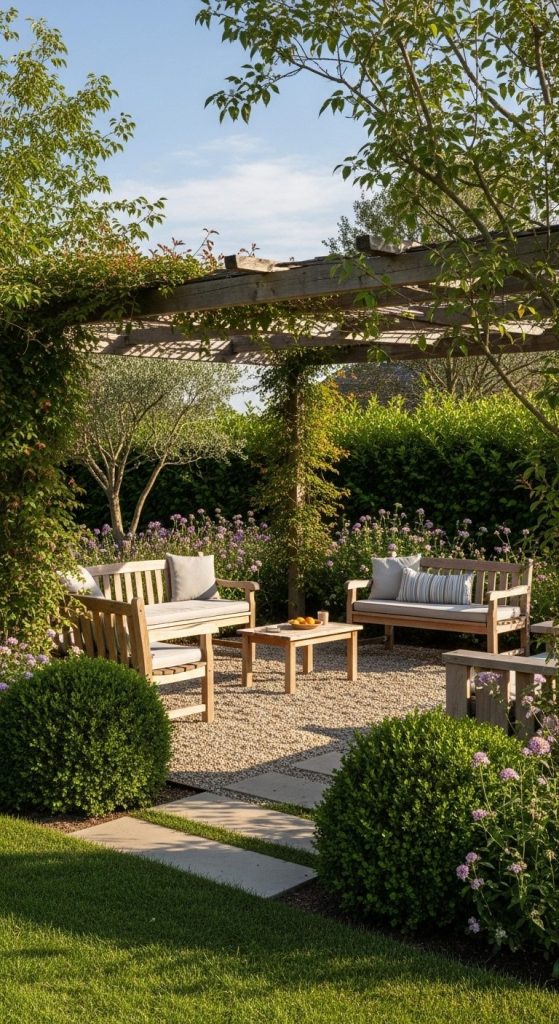
Creating shaded nooks with pergolas, benches, or large trees transforms the villa garden into a comfortable retreat. Perfect for summer afternoons.
Pros
- Provides relief from sun and heat.
- Encourages outdoor socializing or quiet reading.
- Can integrate climbing plants for extra greenery.
Cons
- Construction or installation may require professional help.
- Regular upkeep for pergolas or shade structures.
Takeaway: Shaded zones make your villa garden functional, not just decorative.
7. Vertical Green Walls

Vertical walls planted with greenery or flowers are perfect for adding texture without using much floor space. Ideal near villa entrances or along fences.
Pros
- Maximizes space in compact areas.
- Acts as a natural privacy screen.
- Adds contemporary aesthetic to classic villas.
Cons
- Needs a supporting structure.
- Watering and plant replacement can be labor-intensive.
Takeaway: Vertical gardens combine beauty with practical space-saving benefits.
8. Zen-Inspired Minimalist Garden
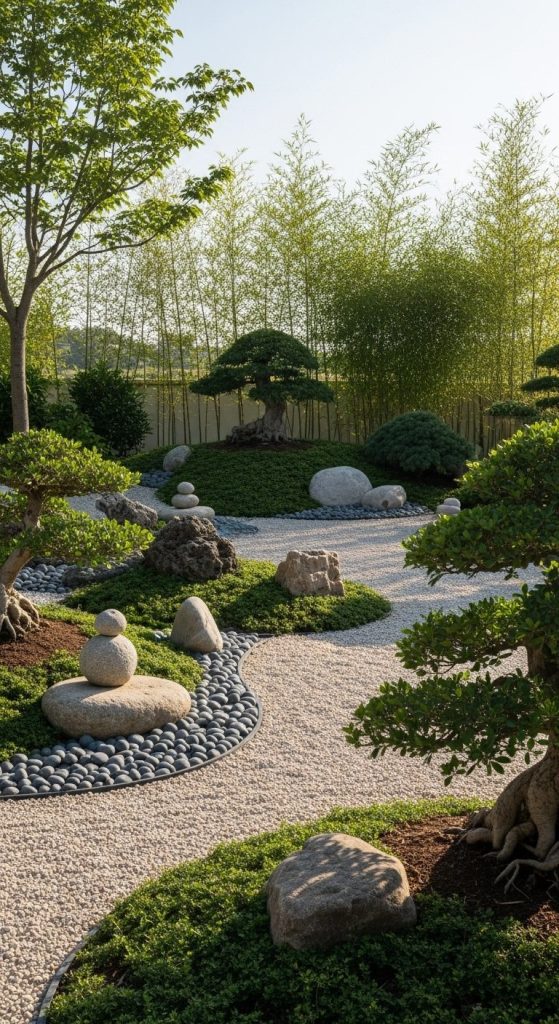
For villas with modern architecture, a Zen-inspired garden with gravel, stones, bonsai, and bamboo creates peaceful simplicity.
Pros
- Low-maintenance once established.
- Encourages meditation and reflection.
- Works well in both front and backyard settings.
Cons
- May feel sparse if not carefully balanced.
- Limited color palette compared to floral gardens.
Takeaway: Minimalist Zen gardens bring calm sophistication to modern villa designs.
9. Poolside Planting

Surrounding a villa pool with palms, hibiscus, or tropical shrubs enhances the resort-like feel. Adds both beauty and partial shade.
Pros
- Elevates villa pool aesthetics.
- Provides a natural screen and privacy.
- Creates a relaxing, vacation-like ambiance.
Cons
- Requires salt or chlorine-resistant plants.
- Needs careful spacing to prevent root interference.
Takeaway: Poolside greenery completes the luxury villa experience effortlessly.
10. Herb and Kitchen Garden

Integrating a small herb garden along pathways or near terraces adds practicality to villa design. Basil, rosemary, and mint are popular choices.
Pros
- Functional; supports cooking and beverages.
- Adds fragrance and small-scale greenery.
- Encourages outdoor engagement.
Cons
- Requires sunlight and regular care.
- Limited space may restrict variety.
Takeaway: Edible gardens combine utility with aesthetic charm.
11. Outdoor Dining Zone with Green Canopy

A villa backyard dining area under a pergola or tree canopy turns meals into memorable experiences. Complement with hanging planters or trellis plants.
Pros
- Encourages alfresco dining and entertaining.
- Can be decorated seasonally for versatility.
- Enhances villa’s social areas.
Cons
- Needs stable furniture and weatherproof materials.
- Occasional leaf or debris cleanup required.
Takeaway: Dining under greenery merges functionality with beauty seamlessly.
12. Courtyard with Central Planters
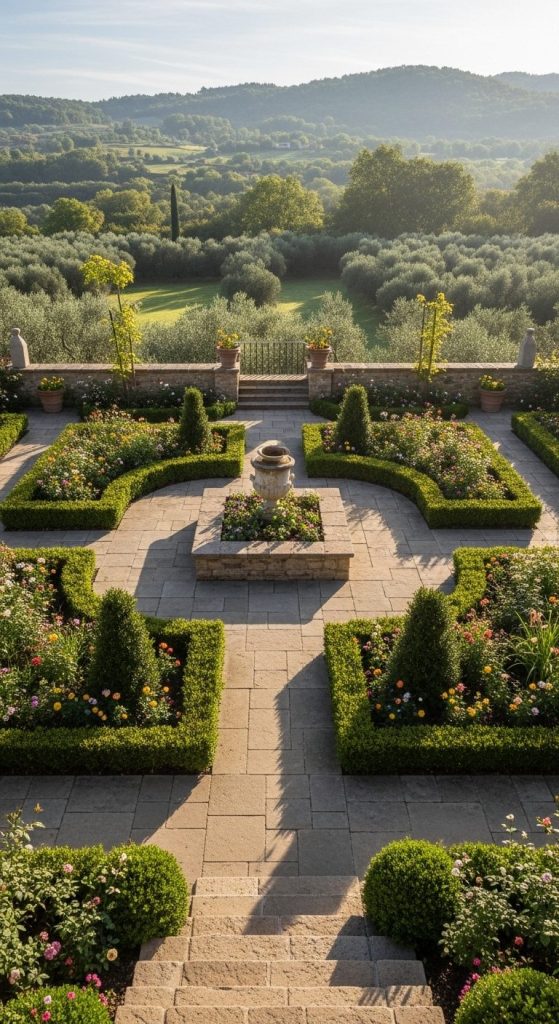
Central courtyard gardens with raised planters create symmetry and easy maintenance. Great for villas with enclosed layouts.
Pros
- Organizes space visually.
- Raised planters protect plants from pests.
- Provides accessible planting areas.
Cons
- Planter construction may be an upfront investment.
- Limited to villa layouts with courtyard space.
Takeaway: Centralized planting zones create visual order and garden focus.
13. Mixed Shrub and Palm Garden

Combining tall palms with medium shrubs and flowering perennials creates depth and tropical flair without overwhelming space.
Pros
- Adds natural height variation.
- Enhances villa privacy with layered planting.
- Offers habitat for birds.
Cons
- Needs planning for sunlight exposure and watering.
- Some palms may take years to mature.
Takeaway: Layered plantings balance luxury with natural aesthetics.
14. Outdoor Fireplace or Firepit Corner

Adding a fire element surrounded by low greenery or climbing plants creates a warm social space for evenings. Perfect for villa backyards in cooler climates.
Pros
- Encourages outdoor gatherings year-round.
- Adds dramatic focal point.
- Complements landscape with cozy ambiance.
Cons
- Installation may require permits.
- Fire safety and maintenance must be managed.
Takeaway: A fire corner adds both warmth and personality to villa gardens.
15. Sculptural Garden Accents
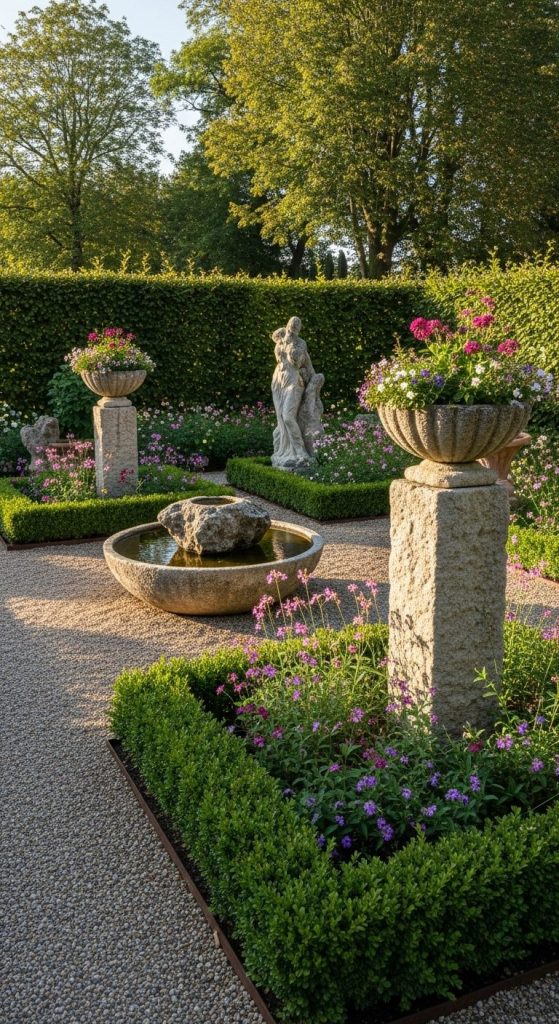
Incorporating statues, water bowls, or artistic planters creates focal points and artistic interest. Choose natural stone or bronze for timeless appeal.
Pros
- Adds elegance and sophistication.
- Guides eye through the garden layout.
- Works with both modern and classic villa designs.
Cons
- Can feel out of place if overused.
- Maintenance and cleaning needed for outdoor exposure.
Takeaway: Carefully chosen garden art elevates design without overpowering greenery.
Conclusion
Villa garden design is about balancing elegance, functionality, and natural beauty. From formal hedges to shaded lounges, vertical greenery, or poolside palms, each element contributes to a space that’s inviting and memorable. Personally, I love the mix of structured layouts with bursts of natural foliage — it keeps the garden alive, dynamic, and visually satisfying. Even small interventions, like a stone path or a potted plant cluster, can transform a villa outdoor space dramatically. Pick the ideas that resonate most, start small, and watch your villa garden evolve into a luxurious retreat that reflects your style.

Ashley Ellison is a skilled writer and avid bowler. Her passion for storytelling and dedication to the sport have led her to participate in various national bowling leagues. With a unique combination of talents, Ashley approaches every challenge with creativity and a relentless drive to succeed.



